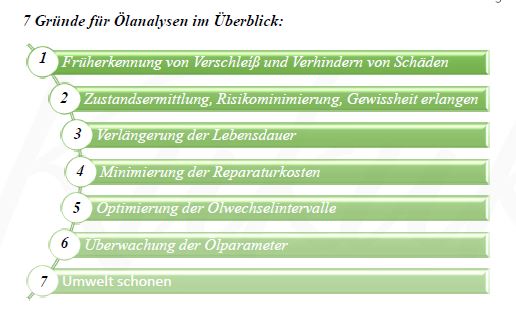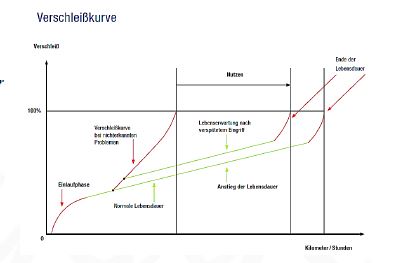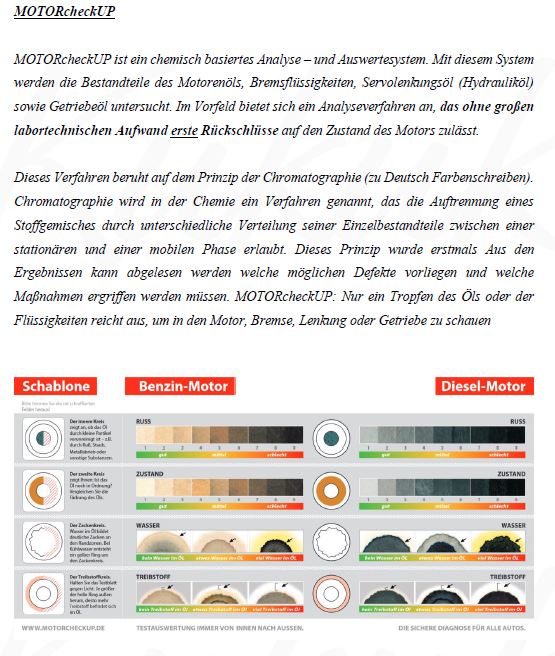Why is an oil analysis useful?
Are the oil ageing processes expected for the mileage? Is there any previously undetected damage or unusual wear? Do you think your engine is not running smoothly and damage is imminent? Is the engine oil you are already using the best for your car? An oil analysis will bring clarity and provide information on necessary repair measures or a necessary oil change.
- Today's highly additivated lubricants are usually not suitable for classic cars. They require unalloyed or very mildly alloyed lubricants.
- Classic car enthusiasts appreciate regular oil analyses. This is because any damage that occurs can be recognised at an early stage before an expensive component has to be replaced.
- With lubricant and oil analyses, you produce less used oil due to longer oil change intervals and thus reduce the burden on the environment. You extend the service life of your machines and their components and utilise your resources more effectively
It's that simple:
- Remove a small amount of oil, send it in, done
- Laboratory testing by one of the world's largest certification companies
- Detailed analysis report with recommendations for action
- Be safe & prevent engine damage
7 reasons for oil analyses at a glance

What information do I receive?
► Increased Iron in the oil can mean, for example, that injection nozzles, injection pump or oil pump are showing wear, or shows wear due to corrosion (water, acids...) or fine rod wear/fretting wear.
► A lot Aluminium in the oil often indicates that something is wrong with the cylinders.
► A lot Silicon indicates dirt, sand and dust, which has an abrasive effect and therefore promotes wear. The air filter system should be checked.
► Lead and copper indicate that all bearings are subject to increased wear and may therefore be damaged.
► An increased Fuel content may be due to the vehicle having been driven frequently on short journeys. The oil has not been heated over a longer period of time so that the fuel has evaporated. Due to too much Fuel the engine oil is diluted and the build-up of a stable lubricating film is impaired.
► Values from Potassium and sodium indicate coolant, the head should be analysed for cracks or other causes of coolant ingress.
► An increased Water content may indicate a defective head gasket.
One Lubricant analysis provides simple information about the state of wear at the heart of the technology. The examination shows whether the oil can still absorb foreign substances and how well the car is really doing. Expensive consequential damage can be avoided and costly and time-consuming oil changes can be better planned.

Which parameters are measured?
- With the ICP process more than 30 different wear metals, impurities and additives can be determined at an optimum detection limit. The wear metals present in the oil are important data carriers. Their presence allows direct conclusions to be drawn about the wear of the components or machine elements from which the particles could originate. It does not matter whether it is corrosive wear or mechanical wear
- With the PQ index In contrast to AES (atomic emission spectroscopy), which cannot detect iron particles > 5 µm, all wear particles that can be magnetised are detected regardless of their size. The difference in the AES iron content is assessed using the result of the PQ index. If the iron value in mg/kg is high, but the PQ index is low, then the iron abrasion is probably caused by corrosion. This is because rust is hardly magnetisable and therefore provides a low PQ index. A high value for the PQ index with simultaneously low iron values from the AES always indicates an acute wear process such as scuffing wear.
- The determination of the Viscosity is used to describe the flow behaviour of liquids. The ISL Houillon viscometer consists of a 40 °C and a 100 °C tempering bath, in each of which 4 capillary viscometers are inserted. The time required for the oil to pass through a certain measuring section is converted into the kinematic viscosity at 40 °C and at 100 °C using the capillary constants. The viscosity values at 40 °C and 100 °C are used to calculate the VI (viscosity index). The higher the VI, the lower the temperature-induced change in viscosity.
- The Infrared spectrum of a sample provides information about oil changes or impurities in comparison to the spectrum of a corresponding fresh or reference oil. For example, oxygen bonds that are newly found in a sample can be used to draw conclusions about oil ageing. Changes in wavenumbers characteristic of OH groups can be interpreted as Water can be interpreted and specified in %. By comparison with the stored fresh oil spectra, the method also provides quick and reliable information as to whether an unknown oil is a mineral oil, "bio-oil" or synthetic oil. Mixing of different oil types can also often be detected.
- The Dirt carrying capacity of engine oils, which provides an indication of engine cleanliness, deteriorates due to additive degradation, oxidation and acidic reaction products from fuel combustion. In addition to IR spectroscopy, the spot shows whether the oil is still able to keep impurities in suspension so that they are transported to the filter and filtered out by an even distribution of soot particles. The intensity of the dark colour shows the soot content. A transparent outer ring shows fuel. With antifreeze glycol, the oil droplet does not spread. Thanks to the incorruptible eye of the camera, the subjective perception of a personal visual inspection can be objectively and reproducibly converted into numerical values.
- Fuel enters the engine oil as condensate during cold starts, via blow-by gases, due to incorrectly adjusted carburettors or incorrect timing, due to clogged air filters or defective injection nozzles. Biodiesel", which is comparatively reluctant to ignite, can also be found as fuel in the oil. Too much fuel dilutes the engine oil and impairs the formation of a stable lubricating film.
- The BN indicates the alkaline reserve of a lubricant for the neutralisation of acids that can arise during a combustion process, for example. The change in the BN allows a significant statement to be made about the further use of oil in a fresh oil comparison.
What types of oil analysis are there?
- Lubricant analyses in the oil analysis laboratory OELCHECK, ANAC, SGS
- Spot test / chromatography = rapid test MOTORcheckUP
Stefan Mitterer, Head of Technology, Service & Sales at OELCHECK GmbH, has the following to say about the spot test: "We do a similar Spot test with diesel or petrol engine oil. But for us, it is first and foremost just a Visual impression. If you have seen a lot of these spots, you can initially suspect extreme fuel ingress, a lot of soot in the oil or coolant ingress. I would expect more precise statements about the condition of the oil or the extent to which various values are really elevated from this do not trust a quick test to read out. I imagine this is even more difficult with transmission or hydraulic oil. Other parameters play a role here than with the engine, but you can hardly tell just from a spot. If the assessment is primarily based on the brightness of the dot, I would be reluctant to recommend a measure or oil change to one of our customers without further information."
A comparison: OELCHECK, SGS, ANAC, Motor Check Up, OILYSE
OELCHECK GmbH
Over 2,500 samples are analysed and evaluated in the OELCHECK laboratories every day. In addition to engine, transmission and differential oils, hydraulic oils, water samples and coolants are also analysed. OELCHECK is the leading laboratory for lubricant and operating fluid analyses in Europe. Our oil analysis laboratory in Brannenburg is state-of-the-art. The basis for an accurate laboratory report is always the sample information form, which you should fill out as completely as possible. This is because our experienced tribologists can only draw precise conclusions as to the cause of any changes in the lubricant by analysing the information on the lubricant type, the period of use of the oil and the details of the machine. They also utilise their extensive background knowledge of systems, machines, production processes and lubricants. OELCHECK tribologists have a sound general knowledge of mechanical engineering and extensive professional experience from a wide range of industries. This knowledge of the systems, machines and production processes in which they are involved is just as important in the preparation of the laboratory reports as their technical application experience with lubricants. The tribologists comment on each laboratory report individually, taking into account all the data and utilising their many years of experience.
ANAC
ANAC is a powertrain diagnostic system based on the scientific interpretation of analysis data obtained from used oil analysis. It enables the fleet manager to reduce the costs of his vehicle / machine fleet and to optimise its use. ANAC is recommended for:
- Systematic monitoring of drivetrain components by analysing wear and lubricant
- Prevention of damage
- Extending the service life of drive components
- Cost reduction per kilometre, mile or operating hour by optimising the necessary maintenance work
SGS
SGS is the world's leading inspection, verification, testing and certification organisation. With more than 89,000 employees, it operates a network of more than 2,600 offices and laboratories around the world. Specialised oil analyses were previously only available for the industrial sector. SGS's Fuel Technology Centre and lubricant laboratory in Speyer (Rhineland-Palatinate) has been analysing the quality of fuels from more than 150 countries for leading vehicle manufacturers and oil companies worldwide for over 30 years. Thanks to SGS's all-round service, this long-standing expertise can now be utilised by everyone for their own vehicles.
With the oil test kit, which is particularly suitable for older cars, motorbikes and motorboats, SGS is now also offering this option to workshops, for example.
MOTORcheckUP
MOTORcheckUP is a chemically based analysis and evaluation system. This system is used to analyse the components of engine oil, brake fluids, power steering oil (hydraulic oil) and transmission oil. An analysis procedure is recommended in advance, without a great deal of laboratory work first Conclusions the condition of the engine.
This process is based on the principle of chromatography (colour writing). In chemistry, chromatography is the name given to a process that allows a mixture of substances to be separated by distributing its individual components differently between a stationary and a mobile phase. MOTORcheckUP: Just a drop of oil or fluid is enough to look inside the engine, brakes, steering or gearbox




